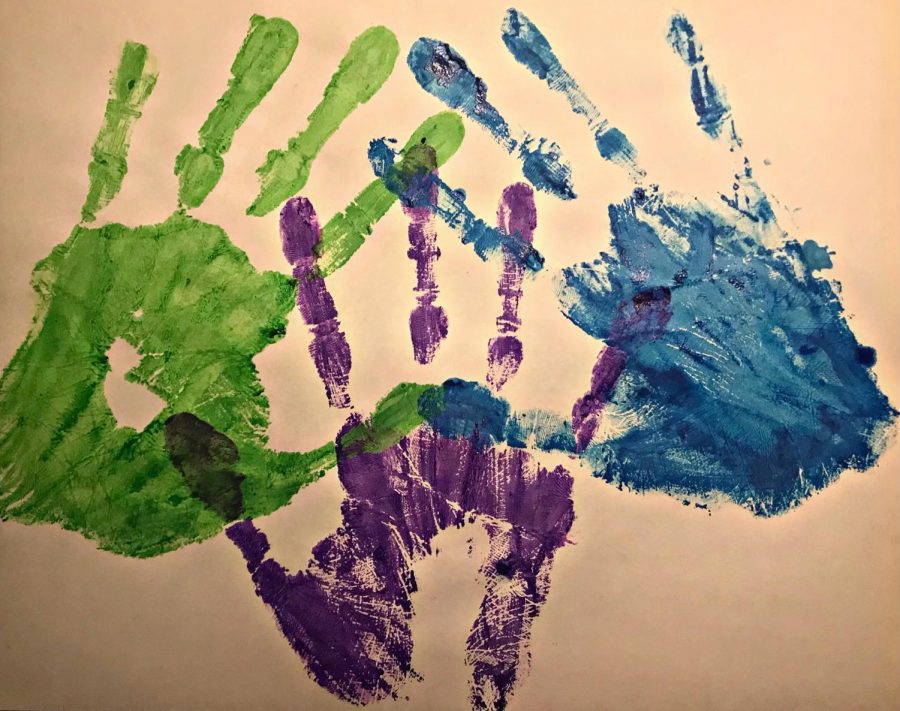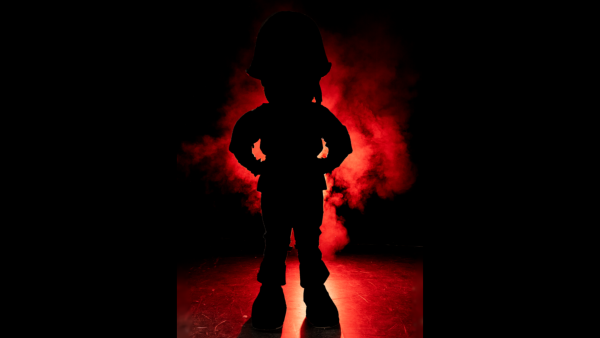Cultural Appropriation v. Appreciation Pt. 2
To represent the cultures that are talked about in this series, senior, Mariam Alashmawi painted hand-prints. Green representing Asian people, purple representing Middle Eastern people, and blue representing the Pacific Islander people.
Racism has existed in America for several years. However, some people are blinded by racism in our country. One great example of this is cultural appropriation. You see it everywhere; TV shows, magazines, runway fashion. We especially see it during Halloween when people get to dress up as whatever they want- well, with a few restrictions that are easy to follow. Cultural appropriation, as discussed in our last series, is when someone takes from culture to fit an aesthetic.
A person’s culture isn’t your costume or fashion statement.
The Asian community has suffered a lot of racism in America. For example, the Chinese Exclusion Act of 1882 suspended Chinese immigration for ten years and declared Chinese immigrants unable to become U.S citizens. This later led to more immigration restrictions and quotas against groups that were deemed “undesirable” in America. The government finally deemed these laws unconstitutional due to the first amendment. The Japanese-Americans were discriminated against during and after World War II, causing them to be in internment camps. However, Asian Americans have influenced the U.S greatly. Let’s take, for example, Chinatown in San Francisco, a densely populated area carrying a traditional look and feel with its authentic food and architecture. It started during the California Gold Rush when Chinese immigrants were only allowed to enter the U.S as laborers. Now it has become an economic staple because of tourism. They have also impacted fashion in the U.S. However, the fashion industry does have a hard time distinguishing the difference in appropriation and appreciation when it comes to their “fashion statement.” A very recent trend, the infamous “fox eye.” This trend is considered to be racially insensitive to the Asian community because their eyes were a source of discrimination. People would tease them by pulling the corner of their eyes back and mock the way they looked.
People have normalized racism towards the Asian community so much that they see nothing wrong with it. That isn’t okay. Other fashion trends that broke the internet is the Chinese cheongsams and the Japanese kimonos in Katy Perry’s appearance at the AMA’s in 2013. This made major headlines and many people took her performance as inspiration for their prom dress. Asian culture isn’t and shouldn’t be used as an aesthetic.
Every single year, on Halloween I see one too many people dress like ancient Egyptians. It’s absolutely ridiculous. The problem lies within not knowing about the culture and not understanding why people wore what they wore back in the day. And there’s always that one person that’s like “Mariam look! I’m dressed like one of your people!” First off, they don’t dress like that in Egypt today and it’s really annoying to hear this very common stereotype about Egyptians. So, I’m gonna politely ask for people to not do that this year. Another thing that the fashion industry has appropriated is headscarves and face coverings. In the Middle East, the predominant religion is Islam. In the Islamic faith, many women cover their bodies, including their hair, which is called a hijab. Muslim women wear hijab for various reasons, such as, cultural pride, family traditions, local customs, and obviously religious purposes. The hijab represents modesty, privacy, and morality. There are many other types of head coverings worn in the Islamic faith like the niqab, burqa, shayla, etc. Many Muslim men and women are criticized for showing their beliefs in America. Many Muslims have been harassed in the streets, have had their head coverings ripped off their heads, and have been told they’re unwanted in this country. But when the Kardashians wear burqas, it’s considered a fashion statement. These customs in Middle Eastern countries are very religious and to make a religion a part of your fashion when you don’t practice the belief, is disrespectful.
Do you remember having Hawaiian Day for spirit week? People would hand out leis and y’all would all wear Hawaiian t-shirts around the school. Well, hate to break it to y’all, but that’s cultural appropriation. The Hawaiian culture is not a theme, and shouldn’t have been. Native Hawaiians were mistreated, oppressed, and killed by the white men. Their land was stolen because their land benefited America’s military and economy. The language has been classified as endangered and we have the nerve to exploit their culture? We all owe the Hawaiian people an apology for doing something so insensitive to their culture. Many people of non-Polynesian descent also decide to get Polynesian tattoos which is extremely disrespectful because tattoos play a significant role in their culture. They believed that their tattoos held spiritual power and made them stronger. Polynesian tattoos can connect to their culture spiritually and we shouldn’t put that on our body if it isn’t apart of our cultures or beliefs. Another thing that has been appropriated in Polynesian culture is tiki bars. Tiki bars have taken objects and symbols of Polynesian culture. They turned Pacific Islander gods into cocktail mugs and ancient designs into the fabric for cabana sets. That is considered disrespectful because we didn’t into consideration what those symbols meant and we disrespected their gods by turning them into mugs.
Some people might say, “We’re not stealing their culture, we’re spreading it.” No. That’s not what you’re doing. You’re trying to get credit for something that’s already been done. It’s unoriginal really. I’ve also heard many people say, “It’s just a hairstyle, get over it.” or “It’s just clothes, it shouldn’t be that offensive.” Sure it’s a hairstyle, but to other people, hair is more than hair. Hair holds so much meaning in different cultures. When we talk about the origination of certain hairstyles and we acknowledge the historical context of it, hair becomes so much more. To talk so vaguely about someone else’s culture shows how arrogant you are because hair holds meaning to some cultures. And clothes- clothing holds so much expression and personality. I understand you didn’t mean for it to come off so offensive, but when you say “it’s just clothes,” it shows that you didn’t put any time or effort into researching the culture. See, cultural appropriation is based on stereotypes, arrogance, and most importantly, racism.
If you would like to spread or show your appreciation, considering doing one or more of the following: 1) Spread awareness about issues going on in their community. You see it all over TikTok, spreading awareness brings people together and teaches others about the issues going on in their community. 2) Donate or support small businesses in that community. Helping small businesses grow will allow them to spread their culture and have more representation. Our appreciation goes a long way if we support them instead of taking from them. 3) Learn about their culture. You can learn about anybody’s culture today because we can access it easily. Learning their language and learning how to make their food are great examples of learning about their culture. You don’t have to dress like a culture to honor the culture.

Mariam Alashmawi is a senior and this is her second year as a staff writer for the Silver Streak.














